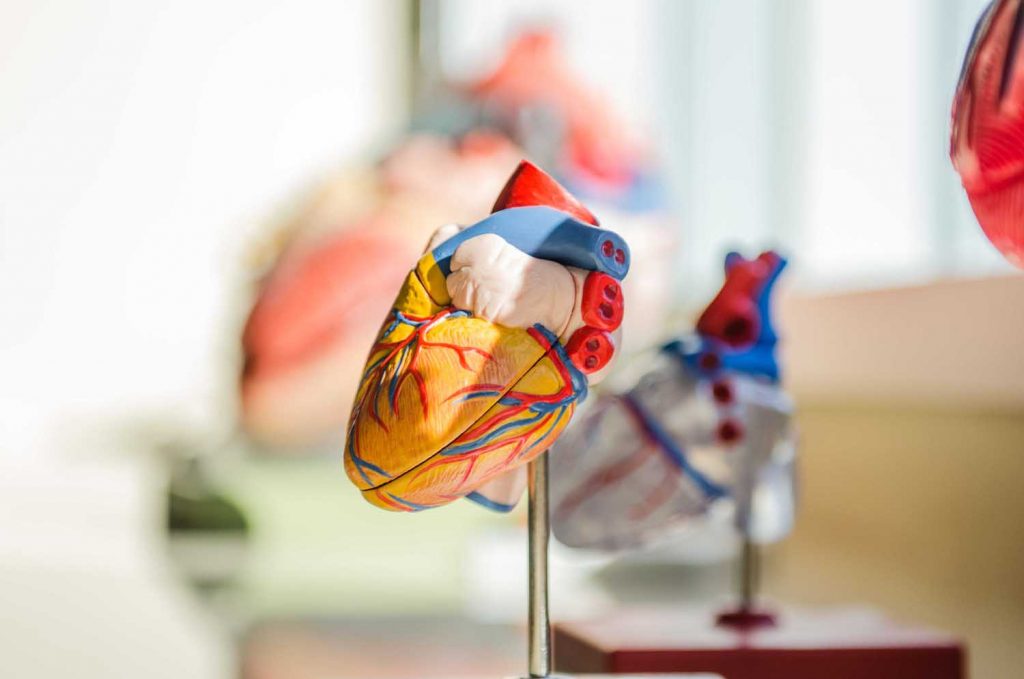Abdominal Aortic Aneurysm
An abdominal aortic aneurysm, also called AAA or triple A, is a bulging, weakened area in the wall of the aorta (the largest artery in the body) resulting in an abnormal widening or ballooning greater than 50 percent of the normal diameter (width).
Angina Pectoris
Angina pectoris (or simply angina) is recurring chest pain or discomfort that happens when some part of the heart does not receive enough blood and oxygen.
Arrhythmias
Arrhythmias are heart rhythm disorders that may originate in the atria (the receiving chambers of the heart) or the ventricles (the pumping chambers of the heart).
Atherosclerosis
Atherosclerosis is a thickening or hardening of the arteries caused by a build-up of plaque in the inner lining of an artery.
Atrial Fibrillation
Atrial fibrillation is a type of arrhythmia where the electrical signals in the atria (the two small chambers of the heart) are fired in a very fast and uncontrolled manner.
Cardiomyopathy
Cardiomyopathy is a heart muscle condition that occurs when the damaged heart does not effectively pump blood.
Carotid Artery Disease
Carotid artery disease, also called carotid artery stenosis, occurs when the carotid arteries, the main blood vessels that carry oxygenated blood to the brain, become narrowed.
Chest Pain / Heart Attack Symptoms
A heart attack, or myocardial infarction, occurs when one of more regions of the heart muscle experience a severe or prolonged decrease in oxygen supply caused by blocked blood flow to the heart muscle.

Coronary Heart Disease
Coronary heart disease occurs when cholesterol builds up within the walls of the heart’s arteries (coronary arteries), forming what is called plaque.
Gout
Gout is characterized by inflamed, painful joints due to the formation of crystal deposits at the joints.
Heart Attack
A heart attack occurs when one or more regions of the heart muscle experience a severe or prolonged lack of oxygen caused by blocked blood flow to the heart muscle.
Heart Failure (Condition)
Heart failure, also called congestive heart failure, is a condition in which the heart cannot pump enough oxygenated blood to meet the needs of the body’s other organs.
Heart Murmurs
Heart murmurs are additional sounds made by blood flowing through the heart as it beats. Many murmurs are harmless (innocent), but some abnormal murmurs might signal a heart problem.
Heart Valve Diseases (Condition)
The heart’s valves can have one of two malfunctions – regurgitation (when the valve does not completely close) or stenosis (a narrowing of the valve).
High Blood Pressure / Hypertension
High blood pressure, or hypertension, directly increases the risk of coronary heart disease (heart attack) and stroke (brain attack).
Metabolic Syndrome
Metabolic syndrome is a condition that includes the presence of a cluster of risk factors specific for cardiovascular disease. Metabolic syndrome significantly raises the risk of developing diabetes, heart disease, and/or stroke.
Mitral Valve Prolapse
Mitral valve prolapse, also known as click-murmur syndrome, Barlow’s syndrome, balloon mitral valve, or floppy valve syndrome, is the bulging of one or both of the mitral valve flaps (leaflets) into the left atrium during the contraction of the heart.
Pericarditis
Pericarditis is inflammation of the pericardium, the thin sac (membrane) that surrounds the heart
Pulmonary Embolism
A pulmonary embolism (PE) is a blood clot that develops in a blood vessel elsewhere in the body (most commonly from the leg), travels to an artery in the lung, and forms an occlusion (blockage) of the artery.
Rheumatic Heart Disease
Rheumatic heart disease is a condition in which permanent damage to heart valves is caused by rheumatic fever.
Thoracic Aortic Aneurysm
A thoracic aortic aneurysm, also called TAA, is a bulging, weakened area in the wall of the aorta (the largest artery in the body), resulting in an abnormal widening or ballooning greater than 50 percent of the normal diameter (width).
